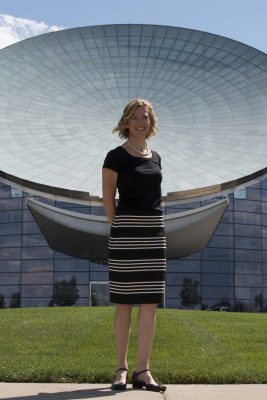Engineer builds satellites, human connections
Pam Johnson ’94 is all about seizing opportunities. Doing so has taken her out of this world.

Johnson, who majored in physics at Cornell, now holds a senior engineering position at DigitalGlobe, which (among other things) operates five satellites that supply Google Earth with its photos from space.
During her time on the Hilltop, she discovered two of her passions: physics and problem-solving. “I learned critical thinking at Cornell,” she says. “I learned how to approach and solve problems, which is an important skill I’ve carried with me. I also learned to seize opportunities. You can’t just sit idle at Cornell.”
Case in point: On her first day at a post-Cornell internship with an environmental engineering firm in the Twin Cities, she was offered and accepted a full-time position as an air quality scientist. Three years later she was pursuing her doctorate in physics at Colorado State University, which led to a job as a systems engineer with Ball Aerospace, introducing her to satellites.
Her team at Ball focused on building a single satellite for five-and-a-half years. Johnson worked on power systems for the spacecraft.
“I worked on determining the requirements,” she says. “We developed and tested the components, modifying them when necessary.”
After arriving at an Air Force base in California for final testing before the launch, her team was told the launch was delayed and might not happen for up to a year. The client wanted to keep the team together for the project, which precluded her from participating in new endeavors at Ball. Sitting around waiting was not in her plans. “I hate being bored,” she says. “I also learned that building a next-gen spacecraft power model was not where my main interests lie.”
An opportunity arose at DigitalGlobe and in Johnsonian fashion, she seized it. She’s been there for eight years and is principal systems engineer and technical lead for development of software that allows interaction with the satellite, and which enables customers to access images and to manage and analyze their data.
DigitalGlobe currently operates five satellites, each of which circles the earth 15 times each day. She was the technical lead for the development of software and DigitalGlobe’s computing cloud infrastructure to support their newest satellite, which was launched in November 2016.
Google is a major client, but the U.S. government is their biggest. They also serve private enterprises like Facebook and Uber, as well as academic and nonprofit institutions. Their satellites also gather data on things ranging from shrinking glaciers to the number of penguins in Antarctica, and they provide public service through a crowdsourcing platform to enable thousands of observers to work on a problem simultaneously. Recent examples are mapping severely impacted areas in Houston immediately following Hurricane Harvey and crowdsourcing the search for the missing Malaysian Airlines Flight 370.
“So much of what I do is help identify and communicate the technical risks as we strive to connect the customer needs to the technology to enable us to make informed decisions,” Johnson says.
“Every day I leverage my technical background as well as my critical thinking and communication skills.”
While not working on DigitalGlobe’s eyes in the sky, Johnson gets outdoors with her husband of six years, Scott Inlow. They spend their free time in decidedly more terrestrial activities, including hiking, biking, and skate skiing. She says they enjoy traveling back roads, museums, small venue concerts, and time with friends.
“Cornell absolutely prepared me for my career,” she says.



